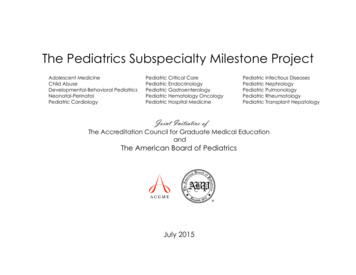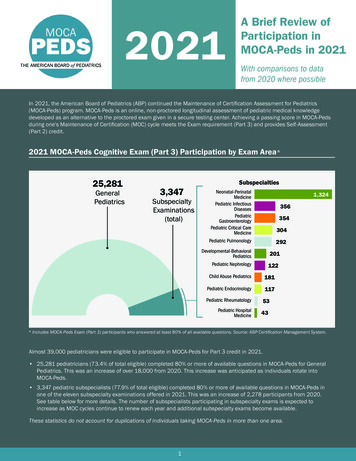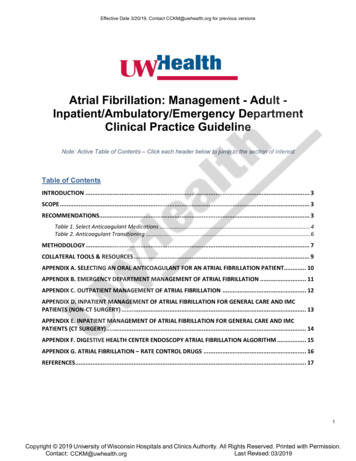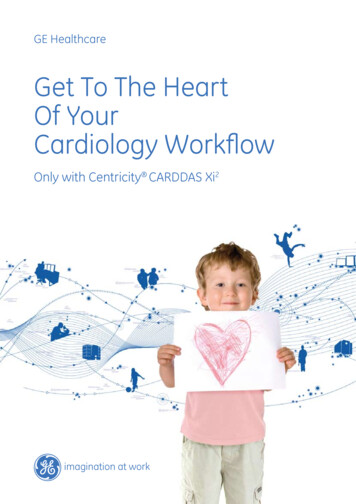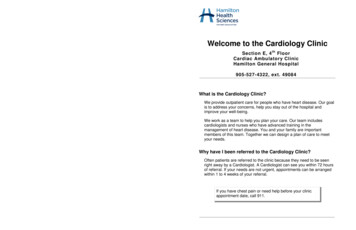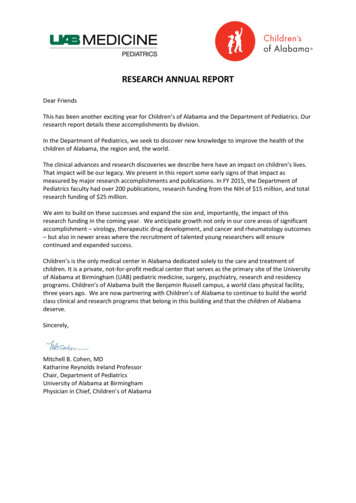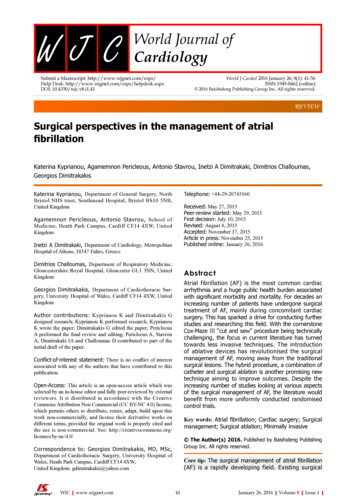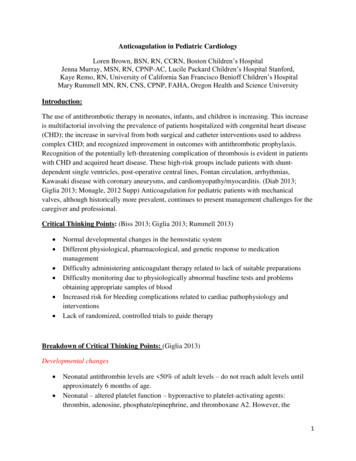
Transcription
Anticoagulation in Pediatric CardiologyLoren Brown, BSN, RN, CCRN, Boston Children’s HospitalJenna Murray, MSN, RN, CPNP-AC, Lucile Packard Children’s Hospital Stanford,Kaye Remo, RN, University of California San Francisco Benioff Children’s HospitalMary Rummell MN, RN, CNS, CPNP, FAHA, Oregon Health and Science UniversityIntroduction:The use of antithrombotic therapy in neonates, infants, and children is increasing. This increaseis multifactorial involving the prevalence of patients hospitalized with congenital heart disease(CHD); the increase in survival from both surgical and catheter interventions used to addresscomplex CHD; and recognized improvement in outcomes with antithrombotic prophylaxis.Recognition of the potentially left-threatening complication of thrombosis is evident in patientswith CHD and acquired heart disease. These high-risk groups include patients with shuntdependent single ventricles, post-operative central lines, Fontan circulation, arrhythmias,Kawasaki disease with coronary aneurysms, and cardiomyopathy/myocarditis. (Diab 2013;Giglia 2013; Monagle, 2012 Supp) Anticoagulation for pediatric patients with mechanicalvalves, although historically more prevalent, continues to present management challenges for thecaregiver and professional.Critical Thinking Points: (Biss 2013; Giglia 2013; Rummell 2013) Normal developmental changes in the hemostatic systemDifferent physiological, pharmacological, and genetic response to medicationmanagementDifficulty administering anticoagulant therapy related to lack of suitable preparationsDifficulty monitoring due to physiologically abnormal baseline tests and problemsobtaining appropriate samples of bloodIncreased risk for bleeding complications related to cardiac pathophysiology andinterventionsLack of randomized, controlled trials to guide therapyBreakdown of Critical Thinking Points: (Giglia 2013)Developmental changes Neonatal antithrombin levels are 50% of adult levels – do not reach adult levels untilapproximately 6 months of age.Neonatal – altered platelet function – hyporeactive to platelet-activating agents:thrombin, adenosine, phosphate/epinephrine, and thromboxane A2. However, the1
bleeding time in neonates, a reflection of platelet function, is normal because of increasedRBC size, Hematocrit and vWF multimers.Different levels of constituent proteins and inhibitors of coagulation (Decreased FII,FVII, FIX, FXI, FXII, protein C, protein S) and fibrinolysis – varies with age.o Greater difference in patients 3 months.o Reach adult levels at approximately 5 years.o Greater impact with cyanotic defects.Physiologically decreased plasma levels of vitamin K-dependent factors.Syndromes that have an effect on coagulation 22q11.2 microdeletion syndromeJacobsenNoonan – thrombocytopenia, platelet dysfunctionMultiple coagulation factor deficiencies – FXICongenital or acquired decrease in hemostatic protein(s)Cardiac conditions and associated issues CHD – especially cyanotic conditions, abnormal blood flow, decreased vessel diameterInvasive cardiovascular (CV) proceduresIndwelling vascular devices – catheters, stents, transvenous pacemaker, septal occluders,and valves -- alter the blood flow shear stress, disrupt the endothelium, and activate thecoagulation system.Inflammatory response to ECMO and bypass circuits, deep hypothermic circulatoryarrestIncreased usage of blood product transfusionSurgically created conduits and shuntsExcessive fibrinolysis, hypothermia, acidosis, decreased platelet countLiver congestion – results in decreased vitamin K-dependent proteins, including proteinsC & S, decreased metabolism of anticoagulantsDecreased renal function – decreased clearance of anticoagulantsHeparin resistanceo Secondary to antithrombin consumption and to competitive heparin binding toinflammation-related circulating proteins.Longer storage of blood products – esp. RBCs results in disruption of coagulation factorsLaboratory tests Samples drawn from central lines and arterial lines may be contaminated with heparinand falsely elevated the levels, should confirm with peripheral stick sampling2
D-dimers (indicative of active coagulation and fibrin production in adults) – not formallyevaluated in children Heparin Levelso ACT , TOTEM, and TEG– no well-designed studies to evaluate safety and efficacy ofuse of ACT to monitor anticoagulation in children – used for ECMO and CP bypasso Anti-Factor Xa Levels Used to measure the effect of UFH and LMWH on coagulation – levelsextrapolated from adult studies. NO pediatric studies establishing the safety andefficacy of any laboratory test to measure the effects of heparin. Poor correlationbetween heparin levels and PTT. LMWH is a short-chain heparin that does not influence the PTT. Therefore, theanti-Factor Xa level is the ONLY measure of the effect of LMWH therap International Normalized Ratio (INR)o Ultimately this means that no matter how or where the lab is drawn it can becompared to another INRo All people, regardless of anticoagulation status, have a baseline INR around 1o Many centers draw a baseline INR and CBC before initial dose of anticoagulanto If the baseline INR is 1.3 (which is common at times in the Fontan and post-pumppopulation) LFTs should be checked as well. INRs post bypass can be falsely elevated due to heightening of the coagulationcascade at this timeIndications for Anticoagulation: (Monagle 2004, 2008; Giglia 2013)3
*Goal INRs for commonly usedventricular assist devices used inpediatrics include:Berlin Heart 2.7-3.5Heartware 2.5-3.5**If a patient has more than oneindication for anticoagulation or hashad a thromboembolic event in thesetting of therapeuticanticoagulation, consider using thehigher of the two ranges orincreasing the range by 0.5 on eitherSpecialized Guidelinesend.Anticoagulation in the immediate post-operative period:(Giglia 2013; Diab 2013; Biss 2013;Monagle 2011, Personal communication, Karamlou, T)Neonates: Systemic – pulmonary Shuntso Placement criteria Palliation in two ventricle repair (Tetralogy of Fallot, severe pulmonary stenosisor right ventricular outflow obstruction,)Include in initial stage I palliation for single ventricle (Hypoplastic right or leftventricle)o Preferred material - polytetrafluoroethylene (Gortex )o Post procedure complications: Significant risk Thrombosis Most significant cause and/or contributor to shunt failure. Associated with hypovolemia related to:o Bleedingo Pleural drainageo Infection Complicated with coagulopathies Assessment includes: Both partial thrombosis/full thrombosis Decreasing and uncorrectable oxygen saturations Marked hypoxemia and decreased cardiac output Management of acute shunt thrombosis Requires immediate intervention: Systemic anticoagulationo Bolus of IV heparin (50-100 U/Kg)o Consider continuous heparin infusiono Monitor UFH levels according to institutional guidelines Increasing systemic blood pressure in effort to improve flow throughshunt4
Intubation, mechanical ventilation and neuromuscular blockade tomaximize oxygen delivery and minimize oxygen consumption Interventional catheterization, manual shunt manipulation , surgicalshunt revisiono ECMO should be anticipatedo Post-operative anticoagulation management Greatest period of management variability Common to use low dose aspirin until next scheduled staged procedure With polytetrafluoroethylene (PTFE) shunt Patient with low risk of bleeding Timing and pharmacologic management controversial Timing and choice of medical management depend on risk factors forcoagulation and personal experience of surgeon Increased risk-factors include:o Age (neonatal developmental coagulation factors)o Elevated pulmonary vascular resistance (PVR)o Shunt 3.5 mmo History of clots or hypercoagulable stateo Stented shunt or native ductus arteriosus Initiation in the operating room Continuous unfractionated heparin (UFH) infusiono Some studies show intraoperative and post-operative UFH for 48hours decrease risk of thrombosiso May increase risk of post-operative bleedingo Therapeutic approach varies: Low-dose (10 - 20 units/kg/hr with no bolus) Full systemic heparinization (Bolus dose of 50-100units/kg followed by 10-20units/kg/HR to achieve atherapeutic PTT (Per hospital guidelines).o Patients with increased risk-factor for thrombosis, Systemic heparinization is recommended for earlypostoperative period Initiation of low dose aspirin varies between centers:o Initial dose given rectally in operating roomo Rectal dose: 20 – 40 mg for neonates or 5 mg/kg for all patients Initiation after leaving the operating room After concerns for bleeding have been resolved.o Normalization of tests of hemostasiso Tests include: Hematocrit, platelet count, PT-INR, aPTT,Fibrinogen level May use UFH or low dose aspirino Some wait to initiate aspirin after chest tubes and pacing wires areouto Others start Low dose aspirin PR with decrease in bleeding risk Patients with sustained high risk for thrombosis,5
o Combined LMWH plus oral low dose aspirin, monitor withAntifactor Xa levels per institutional guidelineso Clopidogrel may be consideredo Monitoring varies between centers: (More specific guidelines suggested later in thisdocument) Anticoagulation continuous until next stage or more definitive establishment ofpulmonary blood flow. Includes PTT, anti-F Xa, AT III levels, heparin levels Continuous depending on agent and coagulation risko Additional considerations: No anticoagulation is recommended for neonates with single ventricle palliationand a Sano shunt. Evaluate coagulation status if chronic effusions Cerebral venous infarct Alter anticoagulation Consult neurologyInfants: Venous to Pulmonary Artery Shunts (Bi-directional Glenn Shunt)oooooooAntiplatelet therapy for ongoing thromboprophylaxis Low dose aspirin – most common Initial timing varies: Rectal dose administered in OR ( 5 mg/kg) Gastric dose (oral or nasogastric tube) started with resumption of bowelsoundsSystemic heparinization if increased risk of clot (infection, stented shunt,hypercoagulable state, line thrombus)Chronic effusions, evaluate for anticoagulation needsCerebral venous infarct Alter anticoagulation Consult neurologyLMWH with ASA/clopidogrel if sustained high risk for clot (stented shunt,hypercoagulable state or existing clot)Decrease use of upper extremity deep venous lines.Maintenance until FontanChildren: Single Ventricle Repair (Fontan)( Monagle, 2011)oRisk Factors of thrombosis: expert opinion/general review Protein -losing enteropathy (PLE) Prolonged pleural effusions Prolonged immobilization Ventricular dysfunction Arrhythmia Presence of thrombogenic foreign material Atrial level fenestration Kawashima connection6
Abnormal thrombophilia profileo Thromboprophylaxis: Short term: warfarin or LMWH for 3-12 months after Fontan palliation Long-term warfarin thromboprophylaxis Use for patients with risk factors Increase or initiation of warfarin magnitude in adolescence andadulthood Stroke prevention warfarin for adults with fenestrations who also havea documented atrial thrombus, atrial arrhythmia, previousthromboembolism Stroke prevention warfarin for adults with atrial level shunts(fenestration) without risk factorsInfants/children: Immediate Post-operative Prosthetic Valve Replacement:o Thromboprophylaxis Varies with type and anatomic location of valve Medical management Initial therapy with UFH as bridge to early management Follow institutional guidelines for management of UFH infusions Patients who cannot take warfarin, low dose aspirin is recommendedAortic Valveo Bi-leaflet mechanical or Medtronic Hall prostheses, No risk factors: warfarin for first 3 months: INR 2.0-3.0 Risk factors: warfarin: INR of 2.5-3.5o Starr - Edwards valves or mechanical disk valves No risk factors: warfarin :INR goal of 2.5-3.5o On-X valve mechanical valve No risk factors: First 6 months: warfarin: INR goal 2.0-3.0 After 6 months: aspirin and clopidogrel or warfarin: reduced INR goalof 1.5o Bioprosthetic valve No risk factors: aspirin Risk factors: warfarin : INR goal of 2.0-3.0Mitral valveo Any mechanical valve Warfarin: INR goal of 2.5-3.5o Bioprosthetic valve No risk factors: aspirin Risk factors: warfarin: INR goal of 2.0-3.07
Adults: Post-operative Prosthetic Valve Replacemento Both low dose aspirin and therapeutic warfarino Pulmonary valve Bioprosthetic valve: may forgo anticoagulationo Tricuspid valve Bioprosthetic valve, normal ventricular function: low dose aspirin Bioprosthetic valve, decreased right ventricular function or risk factors: warfarin:INR goal of 2.0-3.0o Aortic and mitral valve follow same guidelines as childrenManagement Guidelines following immediate post-operative period:Treatment: WarfarinooooInitial Response is usually with 24 hours after administrationPeak anticoagulation response 72 to 96 hr.Duration of action of a single dose is 2-5 daysHalf-life: Following a single warfarin dose, the terminal half-life is about 1 weekwith a mean effective half-life of 40 hr. (range, 20 to 60 hr.)(Prod Info COUMADIN(R) oral tablets, intravenous injection, 2010)Inductiono Dosing is calculated over 7 days (i.e. total WEEKLY dose). Adjustments are madeby increasing or decreasing the weekly dose between 5-20%.o When a rapid effect is required, heparin or low molecular weight heparin should begiven concurrently with warfarin for 4 days or until INR is therapeutic (seeProcedural Bridging section of this document)o Warfarin dosing may be separated into initial and maintenance phaseso INR response is monitored frequently until a stable dose-response relationship isobtainedo Once INR is stable, the frequency of INR testing is reducedo Anticoagulant effect is observed within 2 to 7 days after beginning oral warfarin.Guidelines when using a Loading dose (Children’s Hospital Boston Formulary, Boston,Massachusetts):o Loading Dose: Day 1 Give 0.1 mg/kg (maximum 0.2 mg/kg) - maximum pediatric loading dose is5mg The 0.1mg/kg dose is a routine dose. Consider assessing current medications and diet before deciding on aloading dose knowing that decreased PO intake and medications such8
as antibiotics, steroids, and antiarrhythmics can INCREASE the INRquickly The higher end of loading dose (0.2mg/kg) may be considered when promptelevation in INR desired and the patient’s INR can be monitored very closely(usually on a daily basis). Most often this loading dose is used in patients whohave had cardiac surgery for implantation of mechanical heart valves A loading dose lower than 0.1mg/kg should be considered in patients withFontan physiology, liver disease, decreased vitamin K intake and/or who areknown slow metabolizers If patient was previously on warfarin, start with home dose (or 10%-20%above home dose if INR less than 1.5) Consider dose DECREASING if patients are not eating post-surgery,have chest tubes still in place and/or are on post-op antibioticso Loading Dose: Days 2-7 Check INR in the morning; use each result to plan that evening’s warfarindose: In the patient with baseline normal INR/PT, normal liver functions and who isnot on medication interacting with warfarin, may check INR on days 3, 4, 5and 7 or at clinician’s discretion A reasonable method of adjusting warfarin disease according to INR is asfollows: If INR is 1.1-1.3, repeat the initial loading dose* If INR is 1.4-1.9, reduce the initial loading dose by 50% If INR is 2-3, reduce the initial loading dose by 50% If INR is 3-4, reduce the initial loading dose by 25% If INR is 4-4.4, hold dose, check INR following day then resumewarfarin at 50% of previous dose If INR 4.5, hold until INR 4.5 then resume warfarin at 50% ofprevious dose If INR 5.5, hold and check INR daily, when INR 5, restart at 25%less than previous dose or at discretion of primary clinician. Experienced clinicians sometimes increase the designated initial loading dose25-50% if the response to the chosen loading dose is very slow (e.g., little orno response after two doses). This maneuver shortens the time to therapeuticanticoagulation but increases the risk of overshooting target. In the patient whose baseline physiology and metabolism are stable, the doseon Day 8 of therapy can be calculated by dividing the total dose over the firstweek by 7, and one can proceed to recommendations for Long-TermMonitoring.9
Long Term Monitoring:Treatment: WarfarinRoutine monitoring of INRo Once every 1-4 weeks depending on patient’s age, compliance, and risk forthrombosiso Clinical indications for more frequent monitoring include Antibiotic courses (SBE prophylaxis usually does not affect INRs) Started on new medication known to interact with warfarin or a doseadjustment in a medication known to interact with warfarin GI or other illness that decreased or altered the normal dietary intake Symptoms of bleedingGuidelines for Managing INRMaintaining INRs between 2.0 and 3.0If INR is 1.1-1.4, Check for compliance, if compliant, increase maintenance dose by 20%If INR is 1.5-1.9, increase maintenance dose by 10%If INR is 2-3, no changeIf INR is 3.1-4, decrease dose by 10%If INR is 4.1-4.5, decrease dose by 20%If INR 4.5, hold one dose, then restart 20% lower the previous dose*If INR 5, hold and check INR daily, when INR 4.5, restart at 25% less than the previous doseor at discretion of the primary clinician. *Maintaining INRs between 2.5 and 3.5If INR is 1.1-2, Check for compliance, if compliant, increase maintenance dose by 20%If INR is 2-2.5, increase maintenance dose by 10%If INR is 2.5-3.5, no changeIf INR is 3.6-4.5, decrease dose by 10%If INR is 4.5-5, decrease dose by 20%If INR 5, hold one dose, then restart 20% lower than previous dose**Depending on the reason for anticoagulation and the perceived greater risk (risk of bleed versusrisk of thrombus) dose reduction may be the preferred method of management over holding adose to avoid a possible sub therapeutic level/ thrombus.Other dose adjustment considerations:o When the INR is above the therapeutic range but 5, and the patient is asymptomatic(no clinically significant bleeding) and reversal is not required for surgical10
intervention, the dose of warfarin can be reduced or the next dose omitted andresumed (at a lower dose) when the INR approaches the desired range.o If the INR is between 5 and 9 and the patient is not bleeding and has no risk factorsthat predispose to bleeding, the next 1 or 2 doses of warfarin can be omitted andwarfarin reinstated at a lower dose when the INR falls into the therapeutic range.Alternatively, the next dose of warfarin may be omitted and vitamin K1 (0.5-2 mg)given orally. This approach should be used if the patient is at increased risk ofbleeding.o When more rapid reversal is required to allow urgent surgery or dental extraction,vitamin K1 can be given IV or subcutaneously in a dose of 0.5-2 mg, anticipatingreduction of the INR within 12-24 hours.o If the INR is 9 but clinically significant bleeding has not occurred, vitamin K shouldbe given PO at a dose of 0.5-2mg, anticipating that the INR will fall within 12-24hours. The INR should be monitored closely and vitamin K repeated as necessary.o When rapid reversal of anticoagulation is required because of serious bleeding ormajor warfarin overdose (e.g., INR 20), vitamin K1 should be given by slowintravenous infusion or subcutaneously in a dose of 2-5 mg, supplemented withtransfusion of fresh plasma or prothrombin complex concentrate, according to theurgency of the situation. It may be necessary to give additional doses of vitamin K1every 12 hours.o In cases of life-threatening bleeding or serious warfarin overdose, prothrombincomplex concentrate replacement therapy is indicated supplemented with 5mg mg ofvitamin K1 by slow intravenous infusion; this can be repeated, according to the INR.If warfarin is to be resumed after administration of high doses of vitamin K, thenheparin can be given until the effects of vitamin K have been reversed and the patientagain becomesresponsive to warfarin.11
Treatment: EnoxaparinTreatmentGoal Anti Xa/LMWH level: Standard Risk ofbleeding 0.5-1unit/ml; High Risk of bleeding 0.40.6units/ml.AgeInitial Dosing1.5 mg/kg/dose SC every 2 months12 hours1 mg/kg/dose SC every 12 2 months and 18 yhours1 mg/kg/dose SC every 18 y12hoursooooooBinds to antithrombin to inhibit Factor XaBefore initiating: assess Serum Creatinine and Platelets.Consult Lexi-comp for renal dosing recommendations in patients with elevated CrCLevels need to be drawn for 4-6hrs after 2ND dose is given to be accurate intitration.See below for starting doses for prophylactic and treatment level enoxaparin. ConsultLexicomp and hospital specific guideline for dose adjustment for sub therapeuticlevelsShould not use INSUFLON CATHETERS for doses 5mg or in patients 5kgs or inmedically fragile patientsChronic Anticoagulation Patient Considerations:oSub therapeutic INRs: Inquire about Missed doses or recent dose changes of existing medications Diet or exercise changes (increased exercise, or “healthy” dietary habits canlower an INR) New medications Weight gain/ growth spurt Herbal supplements or herbal/green tea consumption. Anecdotal resourcesindicate that marijuana use will lower INR (Potential Interactions - AlternativeTherapies and Warfarin: Potential Interactions of Herbs with Warfarinhttp://www.medscape.com/viewarticle/406896 2)o Supratherapeutic INRs: Inquire about12
ooo Missed doses that have been caught up (i.e. two doses in 24 hour period) New medications or recent dose changes of existing medications Illness that affects appetite (i.e. sore throat, nausea/vomiting/diarrhea) Alcohol consumptionINR values are affected with many different drugs; antibiotics are the largest groupof medications that will raise an INR in children. Managing practitioners shouldhave INR checked 2 -3 days after beginning a course of therapy to evaluate forelevation and potential dose adjustment and a repeat INR towards the end of thecourse for patients with an INR increase.Patients who have a low intake of vitamin K have been found to have morefluctuation in their INR. A consistent moderate intake or daily supplementation hasbeen shown to decrease fluctuations in INR levels.Dietary considerations Warfarin use in children can present several unique challenges. Chronicallyhospitalized children often have oral taste and textural aversions which create alimited diet. As their dietary intake choices expand, the child who previouslyate little or no dietary vitamin K may suddenly find a food that they like.Although that food may be considered to have comparatively low amount ofvitamin K, this new intake of vitamin K in a previously restricted diet presentsa proportionally large increase in vitamin K compared to their previous diet,and may drive down the INR significantly. A child that consistently gets vitamin K in their diet will have less fluctuationin their INR when that vitamin K intake increases or decreases Children who avoid fruits and vegetables will have a dramatic change (drop) intheir INR when a new food is introduced that does contain vitamin K– even ifit is on the “moderate” or “low” list. (Example– blueberries) The child/ young adult may eat differently during the school year than he orshe does during the summer. There may be a brief adjustment in warfarindosing at the start of the school year and again during the summer. Vacation diets and meals at the holiday may also vary the amount of dietaryvitamin K from the norm. Patients who are having many highs and lows in their INR and do not eatvegetables, may not be getting enough vitamin K in their diet. In these casesthe practitioner may s consider adding a multi-vitamin that has vitamin K to thedaily routine. A dose between 10-40 micrograms of vitamin K daily (more forthe older child). The RDA recommended adult dose is 80 micrograms. Patients receiving formula feedings or supplements should notify theirpractitioner if the formula changes, the amount of volume per feeding, ornumber of feedings per day changes. Most formulas have vitamin K andchanges in rate or volume with alter the amount of vitamin K receive13
Home INR Monitoringo Home INR monitors are available for long term anticoagulation management.Machines may not be feasible for all patients depending on the indication, anticipatedlength of time on warfarin and insurance coverage.o Diagnosis of prosthetic aortic or mitral valve, atrial fibrillation or flutter, stroke ordeep vein thrombosis may be covered by insurance (Pulmonary hypertension,Kawasaki’s disease and Fontan physiology may not be covered diagnoses)o The machine is typically not covered for the first 90 days the patient is on warfarino Requires the anticipated duration of anticoagulation be one yearo Requires testing every other weeko Machines may be available for purchase by the patient/family with a cost ofapproximately 2500 for the machine and testing strips 80 for 6 strips depending onthe model and company.o Studies have shown an increased time in the therapeutic range for patients,improvement of quality of life, and decreased thromboembolic events.The below algorithms are been developed and reviewed jointlyby the Boston Children’s Hospital Cardiology AnticoagulationService and Hematology Anticoagulation Service.Authors: Jenna Murray CPNP-AC, Kathy Harney PNP,Juliann Duzan RN, Christopher Almond MD, MPH, AlanMichelson MD and Cameron Trenor MD14
Procedural and non-proceduralanticoagulation bridging guidelinePhase 1: Pre-ProcedureIs theprocedure HIGHRisk forbleeding?EXCLUSION CRITERIA:-Vascular Malformations-Concurrent Bleeding Diagnoses-Patients that are actively bleeding-Non-adherent patients-Patients that refuse to givethemselves the injection-Patients that have not had LMWHinjection teachingYES: (For Example)NO: (For Example)Cardiac SurgeryDental SurgeryVascular SurgeryEndoscopy (no biopsy)Orthopedic SurgeryCardiac CatheterizationNeuro-SurgeryPacemaker ChangeUrogenital SurgeryLaparoscopic ProcedureEndoscopy (w/biopsy)Gtube ChangesRISK FOR CLOTTINGRISK FOR CLOTTINGRISK FOR CLOTTINGDIAGNOSIS STRATIFICATIONHIGH RISK-Prosthetic Mitral Valve-PE/DVT/CSVT (Within the last 3months)-Kawasaki’s w/Giant CoronaryAneurysms-Left Ventricular Thrombus/IntraCardiac Thrombus (Within the last3 months)-Atrial Arrhythmias another riskfactor (stroke, thrombus, AVR,etc.)MODERATE RISK-Atrial Arrhythmias (only)-Prosthetic Aortic Valve-Long-term secondaryanticoagulation for PE/DVT/CSVTHIGH RiskMODERATE RiskLast dose ofwarfarin- 5days preprocdureLast doseofwarfarin- 5days preprocedureBegin Treatmentdosing of LMWH4 days preprocedureBeginTreatmentdosing ofLMWH 3 dayspre-procedureProsthetic MitralValves:LMWH level afterthe 2nd-3rd dose-Fontan-PH-Cardiomyopathy (sinus rhythm)-DVT ProphylaxisHIGH, MODERATE &LOW RISK FORCLOTTINGDIAGNOSESNo LMWHBridgeLow-Moderate Riskfor ClottingDiagnosesConsider holdingWarfarin 3-4 days preprocedure.Give last doseof LMWH 1224 hours preprocedureHigh Risk for ClottingDiagnosesPROCEDUREConsider dosereducing Warfarin preprocedure to bring theINR down to the lowend of their therapeuticrange.Give last dose ofLMWH 12-24 hourspre-procedureLOW RISKLow RiskPROCEDURE*POD #0*POD #0START PHASE 2AlogorithmSTART PHASE 2Algorithm*Base decision on the patient’s clinical assessment and whenhemostasis is achieved post-procedure and in conjunction withthe surgical/interventional teams15
Procedural and non-proceduralanticoagulation bridging guidelines:PhaseRe2: Post-Procedure*POD #0Is this patienthemodynamically statepost-procedure AND inneed of oralanticoagulation reinitiation?INCLUSION CRITERIA:-2-25 years of age on warfarintherapy(Or patients here at BCH postprocedure and on warfarin therapy)-High or moderate risk for clottingdiagnosis-S/p Phase 1EXCLUSION CRITERIA:-Vascular Malformations-Concurrent Bleeding Diagnoses-Patients that are actively bleeding-Non-adherent patients-Patients that refuse to givethemselves the injection-Patients that have not had LMWHinjection teachingYESRestart treatment dosing ofLMWHAND**Restart warfarinmaintenance dosingPOD #3Test INRIs INR 2 or greater?RISK FOR CLOTTINGDIAGNOSISSTRATIFICATIONHIGH RISK-Prosthetic Mitral Valve-PE/DVT/CSVT (Within thelast 3 months)-Kawasaki’s w/GiantCoronary Aneurysms-Left VentricularThrombus/Intra-CardiacThrombus (Within the last 3months)-Atrial Arrhythmias anotherrisk factor (stroke, thrombus,AVR, etc.)MODERATE RISK-Atrial Arrhythmias (only)-Prosthetic Aortic Valve-Long-term secondaryanticoagulation forPE/DVT/CSVTNOYESStop LMWHContinue onmaintenance dosing ofwarfarinContinue on LMWH ANDwarfarinRetest in 2-3 daysRetest INR 1-2 weeksIf INR is 2 or greater STOPLMWHContinue on maintenancedosing of warfarinRetest INR in 1-2 weeksIf INR is not 2 or greater,go back to previoussquare.Continue until INR is 2 orgreater*Base decision regarding re-initiation on the patient’s clinicalassessment and when hemostasis is achieved post-procedureand in conjunction with the surgical/interventional teams.** Warfarin dosing can be temporarily increase by 10-15% duringthis time to help get the INR back to therapeutic range in a moretimely manner.16
Procedural and nonprocedural anticoagulationbridging guidelines:Phase 3: Subtherapeutic INR*Patients at HIGH risk for clotIs the patient's INR 1.5 ANDhas a HIGH risk for clottingdiagnosis?EXCLUSION CRITERIA-Presenting with potential DVT orstroke symptoms(Please see bleow for list of HighRisk for Clot Diagnoses)YESHas the patient had LMWHinjection teaching?YESNOStart treatment dosing ofLMWHIs the patient/familyable/willing to come to clinic orPCP or VNA for teaching withinthe day?AND*Restart or increase warfarintherapyNOContinue on enoxaparin &warfarin.Retest INR in 2-3 daysYESProvide LMWH injection teachingStart treatment dosing of LMWHAND*Restart or increase warfarintherapyCo
pediatrics include: Berlin Heart 2.7-3.5 Heartware 2.5-3.5 **If a patient has more than one indication for anticoagulation or has had a thromboembolic event in the setting of therapeutic anticoagulation, consider using the higher of the two ranges or increasing the range by 0.5 on either end.



